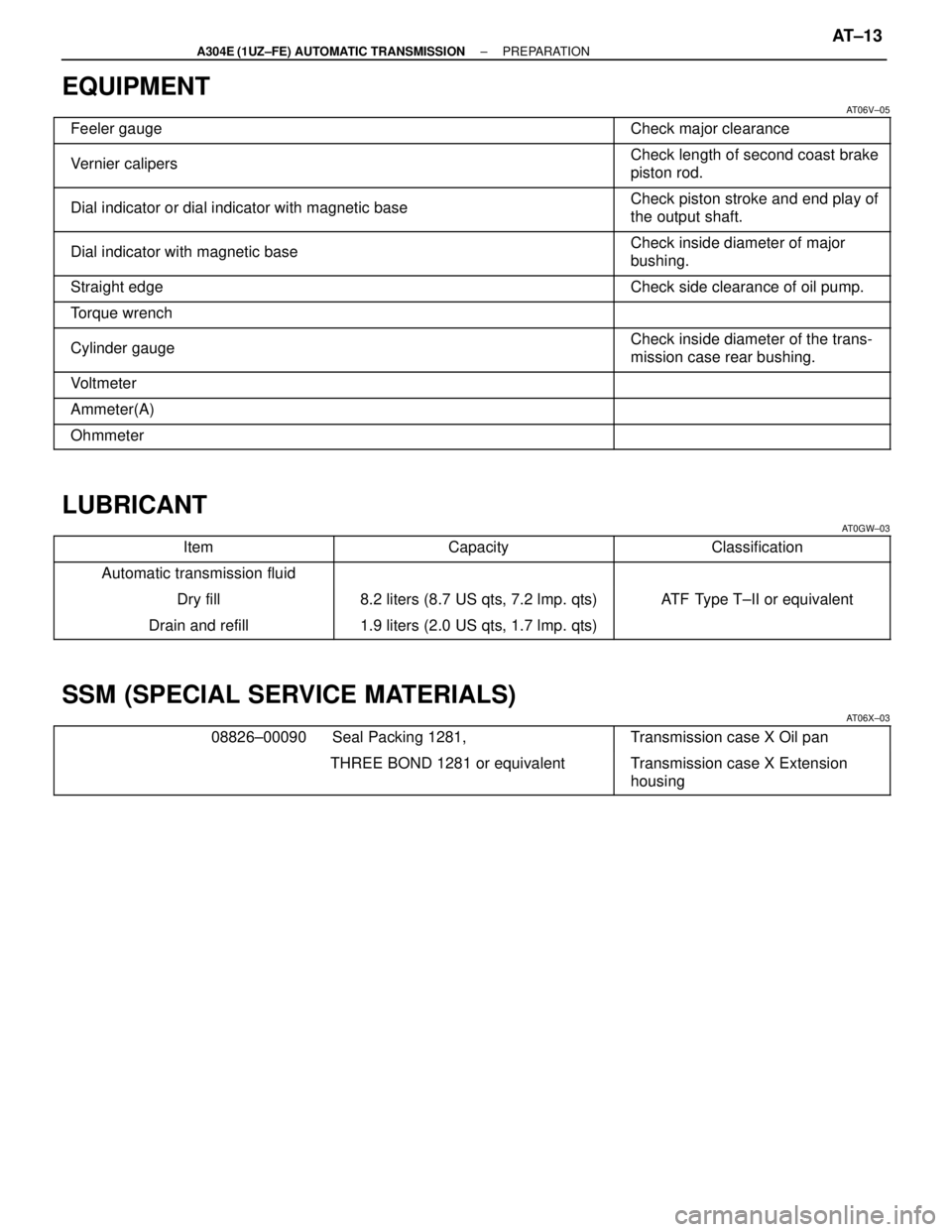Page 297 of 4087

MEASURE ACCUMULATOR BACK PRESSURE
AT0QU±01
NOTICE:
�Perform the test at normal operating fluid temperature 50±80 �C (122±176 �F).
� Be careful to prevent the oil pressure gauge hose from interfering with \
the exhaust pipe.
(a) Warm up the transmission fluid.
(b) Remove the test plug on the transmission case rear right side and connec\
t the oil pressure gauge SST.
SST 09992±00094
HINT: Connecting the oil pressure gauge will be made easier by moving the RH \
side head insulator aside.
(c) Remove the passenger side No.2 under cover and ECM protector.
(d) Connect the SST (check harness A) between ECM and connector of vehicle\
wire harness.
SST: 09990±01000
(e) Install one test lead probe into the terminal SLN of the ECM wire harnes\
s side connector and take care not to ground the other test lead probe.
HINT: Prepare test leads which are connected with an (approximately) 8 W l\
ight bulb.
AT±56
±
A304E (1UZ±FE) AUTOMATIC TRANSMISSION TROUBLESHOOTING
WhereEverybodyKnowsYourName
Page 370 of 4087

2. HYDRAULIC CONTROL SYSTEMThe hydraulic control system is composed of the oil pump, the valve body, the solenoid valves, the accumu-
lators, the clutches and brakes, as well as the fluid passages which connect al\
l of these components.
Based on the hydraulic pressure created by the oil pump, the hydraulic control system governs the hydrau-
lic pressure acting on the torque converter clutch, clutches and brakes \
in accordance with the vehicle driv-
ing conditions.
There are 4 solenoid valves on the valve body.
The No.1 and No.2 solenoid valves are turned on and off by signals from the ECM to operate the shift
valves, and change the gear shift position.
The No.3 solenoid valve is operated by signals from the ECM to engage or di\
sengage the lock±up clutch
of the torque converter clutch.
The No.4 solenoid valve is operated by signals from the ECM to control the \
engagement speed and reduce
gear shift shock.
±
A304E (1UZ±FE) AUTOMATIC TRANSMISSION OPERATIONAT±7
WhereEverybodyKnowsYourName
Page 376 of 4087

EQUIPMENT
AT06V±05������������������\
������ ������������������\
������Feeler gauge������������� �������������Check major clearance������������������\
������ �
������������������\
�����
������������������\
������Vernier calipers
������������� �
������������
�������������Check length of second coast brake
piston rod.
������������������\
������ �
������������������\
�����
������������������\
������Dial indicator or dial indicator with magnetic baseCheck piston stroke and end play of
the output shaft.
������������������\
������ �
������������������\
�����
������������������\
������Dial indicator with magnetic baseCheck inside diameter of major
bushing.
������������������\
������ ������������������\
������Straight edgeCheck side clearance of oil pump.
������������������\
������ ������������������\
������Torque wrench
������������������\
������ �
������������������\
�����
������������������\
������Cylinder gaugeCheck inside diameter of the trans-
mission case rear bushing.
������������������\
������ ������������������\
������Voltmeter
������������������\
������ ������������������\
������Ammeter(A)
������������������\
������ ������������������\
������Ohmmeter
LUBRICANT
AT0GW±03
������������ ������������Item������������� �������������Capacity������������� �������������Classification
������������ ������������Automatic transmission fluid
������������ ������������Dry fill������������� �������������8.2 liters (8.7 US qts, 7.2 lmp. qts)������������� �������������ATF Type T±II or equivalent
������������ ������������Drain and refill������������� �������������1.9 liters (2.0 US qts, 1.7 lmp. qts)������������� �������������
SSM (SPECIAL SERVICE MATERIALS)
AT06X±03
������������������\
������ ������������������\
������08826±00090 Seal Packing 1281,������������� �������������Transmission case X Oil pan
������������������\
������ �
������������������\
�����
������������������\
������
THREE BOND 128\
1 or equivalentTransmission case X Extension
housing
±
A304E (1UZ±FE) AUTOMATIC TRANSMISSION PREPARATIONAT±13
WhereEverybodyKnowsYourName
Page 378 of 4087
6. INSTALL EXTENSION HOUSING REAR OIL SEAL
(a) Coat the lip of oil seal with MP grease.
(b) Using SST and a hammer, drive in a new oil seal with the lipfacing downward.
SST 09309±37010
Oil seal depth from flat end:
0±0.3 mm (0±0.012 in.)
7. INSTALL TRANSMISSION OUTPUT FLANGE
(a) Using SST and a hammer, drive in a new oil seal.SST 09517±36010
(b) Install the output flange and 2 washers.
(c) Using SST, install and torque a new nut. SST 09060±20010
Torque: 123 N Vm (1,250 kgf Vcm, 90 ft Vlbf)
HINT: Shift the shift lever to the P position.
(d) Using a hammer and chisel, stake the nut.
8. INSTALL PROPELLER SHAFT (See pages PR±12)
9. INSTALL FRONT EXHAUST PIPE AND HEAT INSULATOR (See page EG±204)
10. FILL WITH ATF
11. CHECK FLUID LEVEL (See page AT±47)
±
A304E (1UZ±FE) AUTOMATIC TRANSMISSION EXTENSION HOUSINGAT±15
WhereEverybodyKnowsYourName
Page 385 of 4087
4. CONNECT SOLENOID VALVE CONNECTORS
5. INSTALL OIL STRAINER AND GASKETSInstall the oil strainer and torque the 3 bolts.
Torque: 10 N Vm (100 kgf Vcm, 7 ft Vlbf)
6. INSTALL OIL PAN
(a) Install the 4 magnets in the indentations of the oil pan, as
shown in the illustration.
(b) Remove any FIPG material and be careful not to drop oil on the contacting surfaces of the transmission case and oil pan.
(c) Apply FIPG to the oil pan, as shown in the illustration.
FIPG:
Part No. 08826±00090, THREE BOND 1281 or equivalent
(d) Install the oil pan to the transmission case and torque the 19bolts.
Torque: 7.4 N Vm (75 kgf Vcm, 65 in. Vlbf)
7. INSTALL FRONT EXHAUST PIPE
(See page EG±204)
8. CHECK FLUID LEVEL
AT±22
±
A304E (1UZ±FE) AUTOMATIC TRANSMISSION VALVE BODY
WhereEverybodyKnowsYourName
Page 389 of 4087
INSTALLATION MAIN POINTS
AT00L±01
1. CHECK TORQUE CONVERTER CLUTCH INSTALLATIONUsing calipers and a straight edge, measure from the
installed surface of the torque converter clutch to the front
surface of the transmission housing.
Correct distance:
17.1 mm (0.673 in.)
If the distance is less than the standard, check for an improp-
er installation.
2. LIFT ENGINE FRONT SIDE
3. INSTALL THROTTLE CABLE
4. ADJUST THROTTLE CABLE (See page AT±48)
5. FILL TRANSMISSION WITH ATF AND CHECK FLUID LEVEL
(See page AT±47)
NOTICE: Do not overfill.
Fluid type:
ATF Type T±II or equivalent
6. INSTALL PROPELLER SHAFT(See page PR±12 to PR±14 )
7. INSTALL EXHAUST PIPE
(See page EG±204)
AT±26
±
A304E (1UZ±FE) AUTOMATIC TRANSMISSION ASSEMBLY REMOVAL AND INSTALLATION
WhereEverybodyKnowsYourName
Page 1261 of 4087

Coolant which is heated in the water jacket is pumped to the radiator, through which a cooling fan blows
air to cool the coolant as it passes through. Coolant which has been coo\
led is then sent back to the engine by
the water pump, where it cools the engine. The water jacket is a network of channels in the shell of the cylinder bloc\
k and cylinderhead through which
coolant passes. It is designed to provide adequate cooling through the cylinders and combus\
tion chambers
which become heated during engine operation.
RADIATOR The radiator performs the function of cooling the coolant which has pass\
ed through the waterjacket and
become hot, and it is mounted in the front of the vehicle. The radiator consis\
ts of an upper tank and lower tank,
and a core which connects the two tanks. The upper tank contains the inlet \
for coolant from the water jacket
and the filler inlet. It also has a hose attached through which excess cool\
ant or steam can flow. The lower tank
contains the outlet for coolant and drain plug. The core contains many t\
ubes through which coolant flows from
the upper tank to the lower tank as well as cooling fins which radiate heat\
away from the coolant in the tubes.
The air sucked through the radiator by the cooling fan, as well as the wind generated by the ve\
hicle's travel,
passes through the radiator, cooling the coolant. Models with automatic transmission include an aut\
omatic
transmission fluid cooler built into the lower tank of the radiator. A cooling fan is mounted behind radiator to assist
the flow of air through the radiator. When the coolant temperature is low, the fan operates slowly to help the warm
up, and when the coolant temperature becomes high, the fan speed is increas\
ed to provide the air flow required
for cooling.
RADIATOR CAP (on Reservoir Tank)
The radiator cap is a pressure type cap which seals the radiator, resulting in pressurization of the radiator
as the coolant expands. The pressurization prevents the coolant from boi\
ling even when the coolant tempera-
ture exceeds 100 5C (212 5F). A relief valve (pressurization valve) and a vacuum valve (negati\
ve pressure valve)
are built into the radiator cap. The relief valve opens and lets steam esca\
pe through the overflow pipe when
the pressure generated inside the cooling system exceeds the limit (coolant temperature: 110±120 5C
(230±248 5F) pressure; 29.4±98.1 kPa (0.3±1.0 kgf/cm2, 4.3±14.2 psi)). The vacuum v\
alve opens to alleviate
the vacuum which develops in the coolant system after the engine is stopped\
and the coolant temperature
drops.
RESERVOIR TANK The purpose of the reservoir tank is to catch coolant overflows created by \
volumetrix expansion when the
coolant temperature increases. The cap of the reservoir tank is a pressure type\
which prevents deterioration
of the LLC (Long Life Coolant) caused by contact with atmospheric air, increases vaporization performance and
reduces loss of the coolant volume.
WATER PUMP The water pump is mounted on the front of the cylinder block and driven by t\
he reverse side of the timing
belt.
THERMOSTAT The thermostat has a wax type by±pass valve and is mounted in the wat\
er inlet housing. The thermostat
begins to open at the temperature of 80 5C (180 5F). When the coolant temperature is low, the valve closes to
prevent coolant flow to the radiator, thus permitting the engine to warm up rapidly. When the by±pass valve
opens the by±pass circuit, the engine coolant continues to circulate \
inside the engine, quickly and uniformly
warming up to the appropriate temperature. When the coolant temperature is high\
, the valve opens and coolant
flows to the radiator where it is cooled. When the wax inside the thermostat \
is heated, it expands and thus
creates pressure which overpowers the force of the spring which keeps the valve\
closed. When the wax cools,
its contraction causes the force of the spring to take effect once more, closing the valve.
ELECTRONICALLY CONTROLLED HYDRAULIC COOLING FAN (See page CO±22)
±
COOLIING SYSTEM DescriptionCO±3
WhereEverybodyKnowsYourName
Page 1282 of 4087
9. FILL ENGINE WITH COOLANT (See page CO±7)
10. FILL COOLING FAN RESERVOIR TANK WITH FLUID (See pages CO±23 and 24)
11. CHECK AUTOMATIC TRANSMISSION FLUID LEVEL
(See page MA±11)
NOTICE: Do not overfill.
12. START ENGINE AND CHECK FOR LEAKS
13. INSTALL ENGINE UNDER COVER
±
COOLIING SYSTEM RadiatorCO±21
WhereEverybodyKnowsYourName